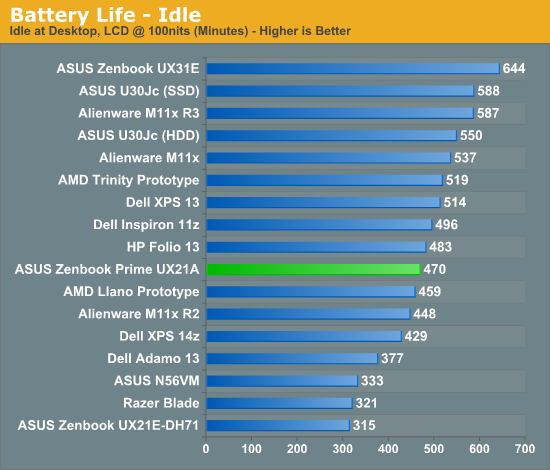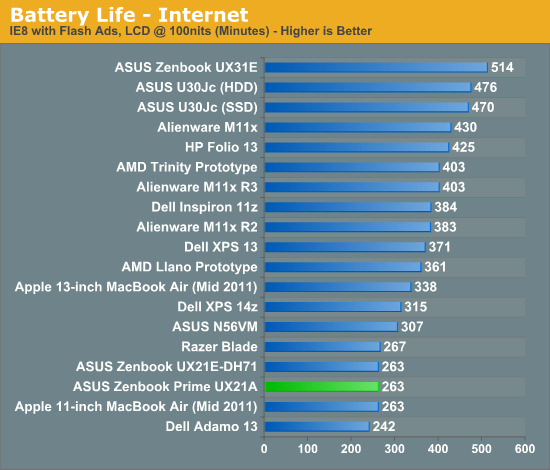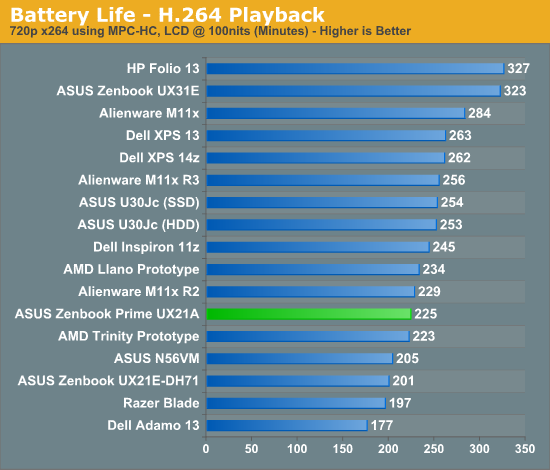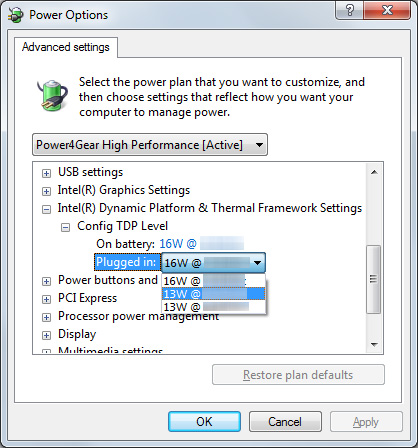ASUS Zenbook Prime (UX21A) Review: The First of the 2nd Gen Ultrabooks
by Anand Lal Shimpi on May 22, 2012 2:46 PM EST- Posted in
- Laptops
- CPUs
- Asus
- Ivy Bridge
- Zenbook
- Zenbook Prime
- Ultrabook
- Notebooks
Battery Life
Generally speaking, the 11-inch Zenbook Prime delivers about the same amount of battery life as its predecessor. For some reason we're able to hit much longer idle battery life on the Prime than the original Zenbook although I'm still trying to find out why. There's also an 11% improvement in our x264 playback test, but on average I'd expect to see similar battery life to the Sandy Bridge model - just with better performance. Note that these results also come despite the fact that ASUS is driving a much higher resolution, and presumably higher power, display than the original Zenbook.



The Zenbook Prime bucks the trend Jarred saw with the first Ivy Bridge notebook review where battery life took a small step backwards. These results bode well for future Ivy Bridge notebooks and Ultrabooks. It still remains to be seen if Intel's 22nm process will actually give us a battery life advantage in any notebook compared to its predecessor. It's possible that we are seeing some of the benefits of 22nm here already and they are simply offset by the more power hungry display. With the move to 22nm Intel should have a better hold on active power and leakage, but it's always possible that we'll have to wait until Haswell for the process to really be exploited.
Just like last time, ASUS has a couple of widgets to quickly change between power settings. The instant on widget lets you switch between suspend to RAM and suspend to disk modes. The former is expected to deliver up to 2 weeks of standby battery life, while the latter can push up to 150 days. I didn't have the time to test these claims (life is short, I draw the line at spending it testing claims of 150 day standby battery life). ASUS once again includes a counter that estimates how long your system will last in either mode based on current charge levels and power usage.
The next widget is a quick tool to let you switch between high performance and battery saver Power4Gear power profiles. You can customize these profiles via the Windows control panel, but it's nice to have a button on the desktop that lets you quickly switch between them.
Configurable TDP
One feature of Ivy Bridge that we haven't been able to test until now is configurable TDP. While most Ultrabook CPUs ship with a 17W TDP, that's mostly an arbitrary thermal/power rating. If an OEM wants to design a chassis that can only accept a 13W part it previously had to hope that Intel would make such a thing. Alternatively, the OEM could underclock/undervolt a 17W chip on their own and hope to mimic Intel's validation and deliver a 13W configuration of their own. The former requires that a significant number of OEMs demand the part, while the latter is just too risky for the larger OEMs (get too aggressive on the undervolting side and end up with a bunch of unstable systems). The solution Intel proposed with Ivy Bridge is configurable TDP. For Ultrabooks this means you can set a 17W part to 13W.

Currently the setting is hidden away in Windows 7's power management settings. Once again I've had to censor the clock speeds here due to Intel's Ultrabook embargo:
You can map the 13W settings to the battery saver profile and then, at the click of a button, have a 13W Zenbook Prime instead of a 17W model. The difference in performance isn't significant however:
| ASUS Zenbook Prime Configurable TDP Performance - Cinebench 11.5 (Multithreaded) | |||||||
| 16W - Max Freq | 13W - Mid Freq | 13W - Lowest Freq | |||||
| ASUS Zenbook Prime UX21A | 2.79 | 2.67 | 2.67 | ||||
I'm still running battery life tests to quantify the impact on power consumption, but it's conceptually a neat thing to see in action finally. I suspect configurable TDP is going to play a major role with Haswell and convertible/dockable Ultrabook-tablet hybrids.
Thermals and Noise
As with most high performance notebooks that are this thin, cooling is difficult. Under load the fans in the Zenbook Prime are definitely audible, but in general ASUS does a better job cooling everything inside the Zenbook Prime than Apple does in the MacBook Air. I suspect much of this boils down to how aggressive Apple is about keeping fan speed/noise down compared to ASUS' desire to maintain a certain temperature level inside the chassis.










192 Comments
View All Comments
Johnmcl7 - Sunday, September 16, 2012 - link
Nor were they the first with an ultralight design either so they need to stop with calling everything a copy of the Macbook Air as it just makes the article writers look ignorant. What is particularly strange is that they even acknowledged the Sony X505 on the first MBA review but seem to have forgotten since so we're back to everything being referred to as Apple again even when they were years after other companies with the design or technology.John
ueharaf - Tuesday, May 22, 2012 - link
i want a vaio z2 comparisson with 1920 x 1080p on both displays...contrast..brights...vieweing angle,etcRoland00Address - Tuesday, May 22, 2012 - link
http://www.anandtech.com/show/5530/sony-vaio-z2-ev...The sony z2 has a negligable lower black point and a higher color gamut.
The asus has a higher contrast ratio, higher brightness (useful when outdoors), and better viewing angles (due to the fact the asus is ips and the z2 is tn.)
Sunburn74 - Tuesday, May 22, 2012 - link
Anand,You did a really nice job with the review. However, I think your battery life comparison is lacking. Can you find way to be more open concerning the varying battery sizes of laptops when discussing their battery life? Something like an adjusted battery life chart or battery life vs size ratio chart?
JarredWalton - Wednesday, May 23, 2012 - link
Battery life doesn't scale with screen size; you can have a 13.3" display that will draw more power than a 17.3" display (at the same brightness), depending on a variety of other factors. It's moderately interesting to consider "best battery life in a [xxx] screen laptop", but that's about as far as I'd take it.Stuka87 - Tuesday, May 22, 2012 - link
For Diablo III to run on intel graphics, you need to turn off AA, an check the box that says "Low FX".I have personally run the game on an i7-2620 (Dual Core, Mobile i7, HD3000) and it ran fine. But that Low FX option and AA is what made it playable. The other settings did not have much of an effect.
Mumrik - Tuesday, May 22, 2012 - link
Fuck yes... More of this please.MobiusStrip - Tuesday, May 22, 2012 - link
The specs chart is lacking a critical characteristic of the screen: glossy or matte?Endeavour1934 - Tuesday, May 22, 2012 - link
It looks like it's semimate, like the VAIO Z and S displays. But I could be wrong...slagar - Tuesday, May 22, 2012 - link
Stunning. Love it. Truly impressive job Asus. True, 4gb RAM is a little of a downer for future-proofing, but I think we're looking at laptop of the year here.